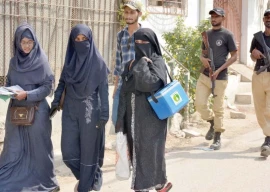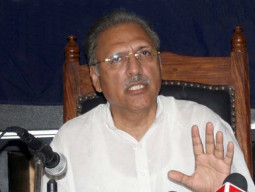
Writing in Sindhi, Urdu and English, he published collections of stories about Sindhi life, biographical sketches of Sindh’s Pirs (saints) and authors and numerous articles on topics, including the history of Islam, the origins of Pakistan and Sindh’s antiquities.
He was the director-general of the Academy of Letters in Islamabad, and was a board member of several learned bodies, such as the Urdu Dictionary Board in Karachi.
He was honoured twice by the President of Pakistan, receiving the Tamgha-e-Imtiaz in 1986, and a shield on the centenary celebrations of Madressah High School in Naushahro Feroze.
Ghulam Rabbani devoted over half a century to the Sindhi Adabi Board. At Mehran, the Adabi Board’s prestigious quarterly research journal, he was the supervising editor.
Through his writing, his energy and his leadership of the Adabi Board, he had a profound impact on Sindh’s intellectual development.
Rabbani was born and raised in a village in Kandiaro, in the heart of Sindh, and it was the depth of his understanding of the soul of Sindh that brought us together in 1976-77, when I was carrying out fieldwork for my PhD on Sindhi history for the University of London’s School of Oriental and African Studies.
I met him soon after he had been appointed pro-vice chancellor of the University of Sindh at Jamshoro. He was extraordinarily helpful, giving me access to the university library and introducing me to academics and scholars.
We used to sit in the garden of his house in Jamshoro until late in the evening. Under a canopy of stars, we discussed life, the world, Sindh and, inevitably, the state of Pakistan. The mid 1970s were a grim period for the world as a whole, but especially for South Asia...
...As a boy in a Sindhi village, Rabbani saheb had seen the injustice of Sindh’s social system for himself and knew how deeply the power structure affected the way people think, especially the landless haris (farm labourers) of Sindh, who accepted the status quo because they could not imagine an alternative.
In my thesis, I was investigating power in rural Sindh in the nineteenth century. In many ways, it was not so different from the 20th and 21st centuries. The countryside was dominated by the big landlords, the waderos. The nineteenth century British officials continuously stressed the importance of izzat to waderos – that is to say, their ‘face,’ or their standing in the local communities.
Rabbani saheb’s anecdotes gave me insights into what this really meant. He emphasised that, whatever the politicians might say, a wadero’s power was not based on physical force, even though some of them made ruthless use of it. It was all about izzat, which he compared to a balloon. ‘The wadero,’ he told me, ‘looks very big, because he is puffed up like a balloon, and so long as he stays puffed up, everyone will do as he says. But one pin-prick and, like a balloon, he is gone!’
In one of his short stories, ‘The Deluge,’ Rabbani saheb describes how a hari allows his family to drown because the wadero ordered him to help repair a canal embankment. He was more frightened of the wadero than of the flood and yet the flood was far more powerful.
I remember two stories from Rabbani saheb’s boyhood which illustrate the reality behind the fiction. The first story was about an old hari whose only buffalo was stolen. The pagi (tracker) traced it to the village of a nearby wadero, so the hari came to the wadero’s autaq, or [den], to plead his cause. He thought the wadero would use his influence to return the buffalo. The wadero listened to his tale in silence then, when he had finished, cried out, ‘Isn’t there anyone here who’ll get rid of this scoundrel?’ Naturally, there was no shortage of sycophantic volunteers. The wadero ordered the old man to be sewn up in a gunny bag and thrown to the dogs. Fortunately, this was real life and not fiction and the dogs did not understand the part they were expected to play, so instead of tearing the hari to shreds, they were just puzzled and sniffed at the bag. Even so, the sight of the old man in the bag tumbling about and screaming caused great hilarity among the wadero and his chamchas. In this case, everyone was under the spell of the wadero’s izzat except the dogs.
In another story, Rabbani saheb heard a great commotion around a nearby wadero’s autaq. A young man had been accused of theft. He crouched on the ground with his head bowed, surrounded by a circle of people. An old man with a stick stood over him. The wadero did not even bother to step outside. He remained inside the autaq, chatting to a friend and called out that the young man had been called a thief. That was enough.
The old man pulled up the young man’s shirt and beat him until his back was streaming with blood. They were father and son. Because the wadero’s men were suspicious of his son, the father believed he must make an example of him to demonstrate the family’s loyalty to the wadero, and perhaps to pre-empt an even more brutal attack from the henchmen. The next day, the young man left the village and did not return for fifteen years, long after his father was dead...
(Note: This article has been edited for space)
The writer did his PhD thesis on ‘Rural power and rural debt in Sind in the late nineteenth century, 1865-1901’ and is the author of Landlord power and rural indebtedness in Colonial Sind, 1865-1901
Published in The Express Tribune, January 18th, 2012.

















COMMENTS
Comments are moderated and generally will be posted if they are on-topic and not abusive.
For more information, please see our Comments FAQ